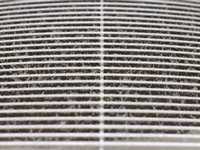- Categories :
- More
John's Corner: What to do with all the storm cleanup mulch chips

Brenda asked me to offer a few comments on how to use or dispose of all the mulch produced from the storms that hit Southeast Texas that is piling up in people’s yards. The ground up branches and limbs from the recent storm cleanup can make a good mulch for one’s yard and flower beds but one needs to be aware of some of the issues involved.
First, there are two major types of equipment to reduce the branches and limbs into mulch. These are chippers and shredders. The mulch produced has very different physical, chemical and biological properties.
Chippers are the most common and use a rotating blade to cut up the branches and limbs into chips. Think of a roll of salami where one cuts off a slice. These are flat chips that pack down easily and have less cell wall destruction hence biodegrade at a slower rate than shredded chips. They do not physically lock together hence are more subject to float off in a rain.
Shredders use what is known as a hammermill to rip the wood apart into longer stringy pieces often with frayed ends. Hammermills cause a lot of cell wall destruction, and the frayed ends allows for much faster decomposition. It also allows for physical locking of the chips to each other and for fungal mats to form trying the chips together. As a result, shredded chips are far more resistant to erosion and floating away.
The second consideration is the size of the limbs that were chipped up. Longtime readers of this newsletter know that healthy soil has a carbon to nitrogen ratio (C:N) of 30:1. Smaller branches 4 inches in diameter may have a C:N of only 150:1, while larger limbs over 4 inches the C:N ratio may be 500:1. This is important as chips with a higher C:N ratio often cause nutrient tie-up if applied more than 1-2 inches thick.
The third consideration is smaller diameter limbs also have a much higher nutrient density and provide nutrients to the soil as they decompose feeding microbes and plants. To use an analogy, we all know that spinach is nutritious and good for us. However, if spinach is all we had to eat we would die of malnutrition. Similarly, if chips from only one species of tree are used then there would not be a diverse range of nutrient as if dozens of species were used to make the chips and similarly less diversity of microbes.
Now let’s look at ways to use the chips. The fastest and easiest is to use the chips to mulch the pathways in one’s garden. A thick layer 4-6 inches works well as it is slow to break down, it will help suppress weeds, and it will improve the soil over time. In this application chip type, C:N ratio, etc. are not as important and it puts a lot of chips to good use.
If one has room, move it out of the way and create a pile 4-5 feet tall and wide (or even larger if there is the need). Water the pile till it has moisture levels like a squeezed-out sponge. Then water it as needed and let it decompose over the next 12 months (partially composting it) and it will shrink concentrating the nutrients, a turn a beautiful dark chocolate brown. Microbe levels will greatly increase, after aging it can be used anywhere in the gardens and earthworms will love it.
If one has different species of material that was chipped up, then alternate layers when forming the pile. If one has only one species and the chips are from larger pieces of wood with a high C:N ratio then one can take it a step further by adding a high nitrogen fertilizer to it like MicrolifeTM Hybrid. Apply the fertilizer as you form the piles so that it is scattered throughout the pile. This will provide the extra nitrogen required for it to quickly decompose. Remember for maximum decomposition rate the pile will need to be kept at 50% moisture content.
If one has been using a good composted (aged) native mulch or a good compost on their flower beds regularly, then the chips can be applied to the flower beds 2-3 inches deep without hurting the plants.
If starting a new raised garden, either chipped or shredded pieces can be used as a base often 10-12 inches thick across the bottom of the bed and then apply one’s soil on top. This is a popular way to make flower or vegetable beds in Europe.
Other uses include erosion control if one has shredded mulch, as a 4-6 inch layer will make a huge reduction in erosion on slopes. Chipped mulch does not work well.
Another use of the chips is to use it as a filter media. One can make a bin (or pile) and fill it with the mulch and use it to filter water (a natural bioreactor). It will remove sediment from rain runoff and as it ages it can biodegrade many chemicals in the water.
The mulch chips 1-2 inches thick can also be used to dop dress flowerpots and other containers. It will help the soil stay cooler and slow evaporation.
A few things to consider. During a tropical storm like Ike, Harvey, Beryl, etc., weak or damaged trees are the first to be blown down. Some common diseases of these weaken trees are Verticillum wilt which is caused by a soil-borne fungus resulting in the decline or death of many shrubs and trees. Rhizoctonia solani is another plant pathogen that is stimulated by freshly ground mulches as it feeds off the cellulose in the wood. If diseased trees are ground up and used for mulch, it is possible that these diseases can spread to mulched plants. Proper composting can eliminate this issue.
Another problem that sometimes occurs in mulch is called the "Toxic Mulch Syndrome" or "Sour Mulch." This most often occurs with bark mulches (pine, hardwood, etc.) and mulch from storm clean-up but can happen with almost any organic mulch. It occurs when a fine grained (small particle size) mulch is stacked over 6 feet high, remains wet for long periods of time and does not get airflow through the pile. The material compresses and starts fermenting (anaerobic decay instead of beneficial aerobic decay) and produces chemicals (methanol, acetic acid, ammonia, hydrogen sulfide and others) that can kill annuals and damage many woody perennials. Note: It only takes 1 ppm (part per million) of alcohol (like methanol) to kill a plant root!
This is more common on mulch from storm cleanup sites where large commercial grinders are used to reduce the volume of material and quality is of no concern.














